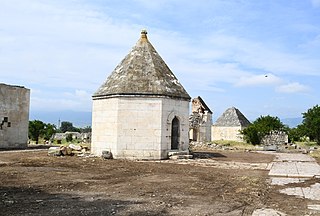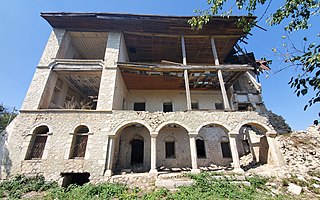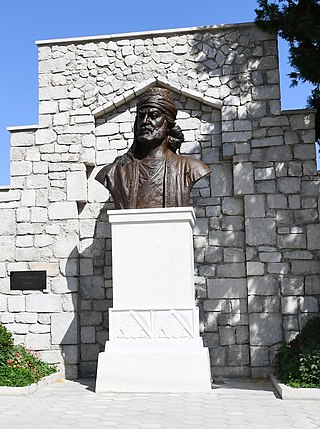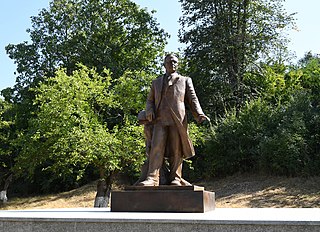
Shusha District is one of the 66 districts of Azerbaijan. It is located in the west of the country and belongs to the Karabakh Economic Region. The district borders the districts of Khojaly, Lachin, and Khojavend. Its capital and largest city is Shusha. As of 2020, the district had a nominal population of 34,700. Finally villages of Malıbəyli, Aşağı Quşçular and Yuxarı Quşçular were transferred to Khojaly District according to passing law in 5 December 2023.

The Karabakh is a mountain-steppe racing and riding horse breed. It is named after the Karabakh region, from which the breed originates. The breed is noted for its good temperament and speed; in 2004, a Karabakh horse named Kishmish from an Aghdam stud farm covered 1,000 metres (3,300 ft) in 1.09 minutes and 1,600 metres (5,200 ft) in 1.52 minutes.

Khurshidbanu Natavan was an Azerbaijani poet and philanthropist. She is considered one of the best lyrical poets of Azerbaijan. Her poems are in either Azerbaijani or Persian and she was most notable for her lyrical ghazals.

Zarysly is a village located in Shusha district of Azerbaijan, and is the center of the Zarisli rural administrative-territorial district.

The National museum of Azerbaijan literature, named after Nizami Ganjavi is a museum in Baku, established in 1939. It is located near the entrance of Icheri Sheher, not far from the Fountains Square. The museum is considered one of the greatest and richest treasuries of Azerbaijani culture.
The story of the press in Azerbaijan began with Akinchi, the first Azerbaijani-language newspaper, published by Hasan bey Zardabi in Baku between 1875 and 1877. Other newspapers followed through the remainder of the 19th century. This was a time of re-emergence for Azerbaijani literature in general.
The monument to Nizami Ganjavi is a monument to the outstanding Persian poet Nizami Ganjavi, located in the hometown of the poet, Ganja, Azerbaijan. The monument was erected in 1946.

The Palace of the Karabakh Khans or the Palace of Panah Ali Khan is a palace located in the historical center of the city of Shusha, the former residence of the founder of the Karabakh Khanate, Panah Ali Khan. During the reign of Panah Ali Khan, the palace was also the residence of the ruler where he lived together with his family. His son, Ibrahimkhalil Khan, together with his family and followers settled in the Palace of Ibrahimkhalil Khan built in the same period. For the eldest son of Ibrahimkhalil Khan, Mukhammedhasan Agha, another palace was built on a sheer cliff in the southeast of the Shusha plateau. In addition to these palaces, the Palace of the Khan's daughter, Natavan, and the Palace of Gara Boyuk khanim, belonging to the Khan's family, were also built in Shusha. Although in various sources the name of the Palace of the Karabakh Khan is attributed to each of these buildings, the main political residence of the Karabakh Khans was the palace-castle of the first Karabakh Khan, Panah Ali Khan.

The Imarat Garvand cemetery, or simply as the Imarat cemetery is a royal cemetery and a complex located in Aghdam, Azerbaijan. It contains the graves of some of the Azerbaijani and Turkic nobility of the Karabakh Khanate.

The House of Khurshidbanu Natavan, also known as the Palace of Natavan, Daughter of the Khan, is an 18th or 19th-century historical and architectural monument, and a museum in Shusha, Azerbaijan.
The Bust of Khurshidbanu Natavan, also known as the Monument of Natavan, Daughter of the Khan, is a public bronze bust of Khurshidbanu Natavan displayed in Shusha, Azerbaijan. The bust, made by the Azerbaijani sculptor Hayat Abdullayeva and unveiled in 1982, was heavily damaged by the Armenian forces when they captured Shusha in 1992, during the First Nagorno-Karabakh War, and was transferred to Armenia. It was then bought by the Azerbaijani authorities in Georgia, and transferred to Azerbaijan, to be displayed in the yard of the Azerbaijani National Museum of Art in Baku. In 2020, the Azerbaijani forces recaptured Shusha, and the bust was returned to the city in January 2021.
Ali Aziz oghlu Ibadullayev is an Azerbaijani sculptor and painter.

The Zohrabbayovs' house is a 19th-century building that belonged to the representative of the noble Shusha family of the Zohrabbayovs, to Abbasgulu bey Zohrabbayov.
Following the Second Nagorno-Karabakh War, and in accordance with 2020 Nagorno-Karabakh ceasefire agreement, Republic of Azerbaijan re-established authority on the part of the territories, previously de facto controlled by the breakaway Republic of Artsakh, which allowed Azerbaijan to begin construction projects and rehabilitation in areas of the Karabakh, many of which had been practically leveled since Azerbaijan lost control of them in the 1990s.

Shirin Su bathhouse or the Bathhouse of the Fresh Water is a historical monument located in the city of Shusha. It was built in 1878–1880 at the order of Khurshidbanu Natavan by the architect of Kerbelayi Sefikhan Garabaghy. On 2 August 2001, the Cabinet of Ministers of the Republic of Azerbaijan, by the Resolution No. 32, registered it as a historical monument of a republican significance.

Bust of Molla Panah Vagif is a bust raised in the honour of the famous Azerbaijani poet, political and public figure of the 18th century, Molla Panah Vagif. It was destroyed after the capture of the city of Shusha in 1992 by the Armenian forces. It was renovated in 2021 after the city was liberated by the Azerbaijani armed forces in 2020.

Monument to Shah Ismail Khatai is a monument raised on one of the streets of Baku (Azerbaijan) in the honour of Shah Ismail Khatai, the king of Safavid Iran.

Statue of Uzeyir Hajibeyov is a monument erected in 1985 to Uzeyir Hajibeyov, an Azerbaijani composer, musicologist-scientist, publicist, dramatist, pedagogue and public figure, founder of modern Azerbaijani professional music art and national opera, composer of the national anthem of the Republic of Azerbaijan, author of the first opera in the Muslim East, in his hometown of Shusha. The statue became a victim of vandalism after the city of Shusha came under Armenian control. After the liberation of the city, it was restored in 2021, and its official opening took place on August 29.

"Khan gizi" spring is a spring located next to Khan's daughter Natevan's palace in the Çöl Qala neighborhood of Shusha. The spring was built in the 19th century by the order of Khurshidbanu Natavan.















